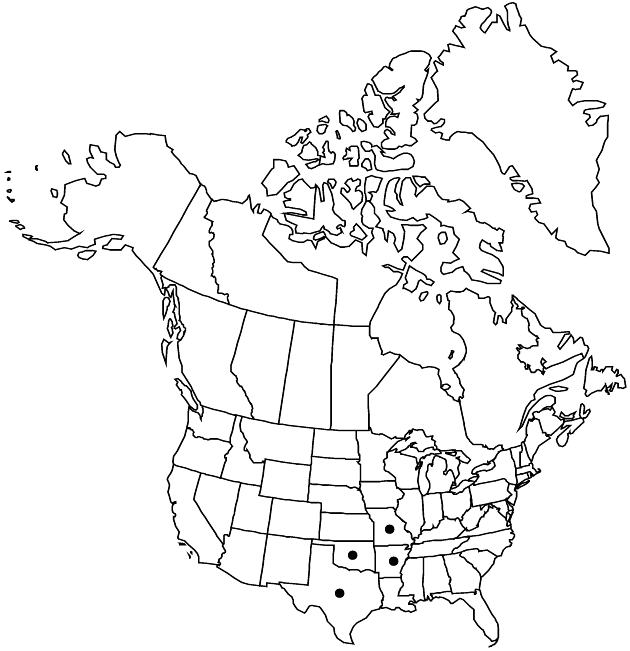Difference between revisions of "Echinacea paradoxa"
in N. L. Britton and A. Brown, Ill. Fl. N. U.S. ed. 2, 3: 476. 1913.
FNA>Volume Importer |
FNA>Volume Importer |
||
| Line 7: | Line 7: | ||
|year=1913 | |year=1913 | ||
}} | }} | ||
| − | |basionyms={{Treatment/ID/ | + | |basionyms={{Treatment/ID/Basionym |
|name=Brauneria paradoxa | |name=Brauneria paradoxa | ||
|authority=Norton | |authority=Norton | ||
| + | |publication_title=Trans. Acad. Sci. St. Louis | ||
| + | |publication_place=12: 40, plate 8. 1902 | ||
}} | }} | ||
|synonyms= | |synonyms= | ||
| Line 19: | Line 21: | ||
}}<!-- | }}<!-- | ||
| − | --><span class="statement" id="st-undefined" data-properties=""><b>Plants </b>to 90 cm (roots fusiform to elongate-turbinate, branched). <b>Herbage</b> sparsely to densely hairy (hairs appressed to ascending). <b>Stems</b> usually yellowish green (usually not branched). <b>Basal</b> leaves: petioles 0–15 cm; blades (3-) or 5-nerved, usually linear or lanceolate, rarely ovate, 5–35 × 0.5–2(–2.5) cm, bases usually attenuate, margins entire (usually ciliate). <b>Peduncles</b> (2–)10–30 cm. <b>Phyllaries</b> lanceolate to ovate, 7–12 × 1–4 mm. <b>Receptacles</b>: paleae 10–14 mm, tips red to orange, often incurved, sharp-pointed. <b>Ray</b> corollas yellow (<i></i>var.<i> paradoxa</i>) or pinkish to white (<i></i>var.<i> neglecta</i>), laminae reflexed, 30–70 × 3–8 mm, sparsely hairy abaxially. <b>Discs</b> ovoid to conic, 2–3.5 × 2–3.5 cm. <b>Disc</b> corollas 4.5–6.2 mm, lobes pinkish to yellowish. <b>Cypselae</b> tan or bicolored (with distal dark brown band), 4–5.5 mm, faces ± tuberculate, usually glabrous (angles of ray cypselae hairy distally in <i></i>var.<i> neglecta</i>); pappi to ca. 1.2 mm (major teeth 0–4).</span><!-- | + | --><span class="statement" id="st-undefined" data-properties=""><b>Plants </b>to 90 cm (roots fusiform to elongate-turbinate, branched). <b>Herbage</b> sparsely to densely hairy (hairs appressed to ascending). <b>Stems</b> usually yellowish green (usually not branched). <b>Basal</b> leaves: petioles 0–15 cm; blades (3-) or 5-nerved, usually linear or lanceolate, rarely ovate, 5–35 × 0.5–2(–2.5) cm, bases usually attenuate, margins entire (usually ciliate). <b>Peduncles</b> (2–)10–30 cm. <b>Phyllaries</b> lanceolate to ovate, 7–12 × 1–4 mm. <b>Receptacles</b>: paleae 10–14 mm, tips red to orange, often incurved, sharp-pointed. <b>Ray</b> corollas yellow (<i></i></i>var.<i><i> paradoxa</i>) or pinkish to white (<i></i></i>var.<i><i> neglecta</i>), laminae reflexed, 30–70 × 3–8 mm, sparsely hairy abaxially. <b>Discs</b> ovoid to conic, 2–3.5 × 2–3.5 cm. <b>Disc</b> corollas 4.5–6.2 mm, lobes pinkish to yellowish. <b>Cypselae</b> tan or bicolored (with distal dark brown band), 4–5.5 mm, faces ± tuberculate, usually glabrous (angles of ray cypselae hairy distally in <i></i></i>var.<i><i> neglecta</i>); pappi to ca. 1.2 mm (major teeth 0–4).</span><!-- |
-->{{Treatment/Body | -->{{Treatment/Body | ||
| Line 58: | Line 60: | ||
|publication year=1913 | |publication year=1913 | ||
|special status= | |special status= | ||
| − | |source xml=https://jpend@bitbucket.org/aafc-mbb/fna-data-curation.git/src/ | + | |source xml=https://jpend@bitbucket.org/aafc-mbb/fna-data-curation.git/src/f6b125a955440c0872999024f038d74684f65921/coarse_grained_fna_xml/V19-20-21/V21_210.xml |
|tribe=Asteraceae tribe Heliantheae | |tribe=Asteraceae tribe Heliantheae | ||
|subtribe=Asteraceae (tribe Heliantheae) subtribe Ecliptinae | |subtribe=Asteraceae (tribe Heliantheae) subtribe Ecliptinae | ||
Revision as of 18:47, 24 September 2019
Plants to 90 cm (roots fusiform to elongate-turbinate, branched). Herbage sparsely to densely hairy (hairs appressed to ascending). Stems usually yellowish green (usually not branched). Basal leaves: petioles 0–15 cm; blades (3-) or 5-nerved, usually linear or lanceolate, rarely ovate, 5–35 × 0.5–2(–2.5) cm, bases usually attenuate, margins entire (usually ciliate). Peduncles (2–)10–30 cm. Phyllaries lanceolate to ovate, 7–12 × 1–4 mm. Receptacles: paleae 10–14 mm, tips red to orange, often incurved, sharp-pointed. Ray corollas yellow (var. paradoxa) or pinkish to white (var. neglecta), laminae reflexed, 30–70 × 3–8 mm, sparsely hairy abaxially. Discs ovoid to conic, 2–3.5 × 2–3.5 cm. Disc corollas 4.5–6.2 mm, lobes pinkish to yellowish. Cypselae tan or bicolored (with distal dark brown band), 4–5.5 mm, faces ± tuberculate, usually glabrous (angles of ray cypselae hairy distally in var. neglecta); pappi to ca. 1.2 mm (major teeth 0–4).
Distribution

sc United States.
Discussion
Varieties 2 (2 in the flora).
Selected References
None.
Key
| 1 | Ray corollas yellow; n Arkansas, s Missouri | Echinacea paradoxa var. paradoxa |
| 1 | Ray corollas light purple, pink, or white; s Okla-homa, n Texas | Echinacea paradoxa var. neglecta |